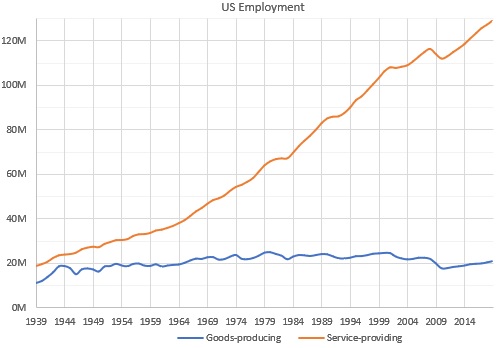A variation of cost disease
In the long run, a society’s prosperity is dependent on productivity growth. One of the conundrums societies face in respect to this is, that as economies become more advanced, they become dominated by industries with low productivity growth. This is best seen in the growth of service industries, which mostly have low productivity growth. The following chart1 shows this domination by comparing US employment in service producing industries against employment in goods producing industries.

The Baumol effect - or more colloquially, cost disease - is a theory that offers an explanation to this above phenomenon. Its main postulates are:
- As wages rise in high productivity industries they must also rise in low productivity industries in order for them to retain or attract workers.
- Over time, society will continue to consume goods and services from both industries (low productivity growth and high productivity growth). Assuming the ratio of the consumption levels between these two industry groups remains about the same, then the proportion of people employed in low productivity industries must increase. This is because less workers are needed in industries with greater productivity to produce their goods and services.
These two postulates go some way to explaining why low productivity industries tend to dominate advanced economies. However the extent to which it causes this phenomenon is subject to debate and studies.
My personal view is that this theory could be improved by taking the following into account:
- As the proportion of people employed in the industry with high productivity reduces, its ability to affect wages in less productive industries should decrease.
- Productivity improvements are hard. They often involve adoption of new innovations which can have significant risk attached. Management will in most cases only take on these risks if substantial pressures are placed on the business. Competition or responding to changing market demand are examples of such pressures.
- If competition is driving productivity improvement, we would expect that consumers would receive most of the benefits of productivity improvements - not workers.
- It is far easier for goods producing businesses to transfer their operations (with associated employment) to other countries with lower costs.
The real challenge for advanced economies is improving the rate of productivity increase in service industries. I believe that dominant factor causing this low productivity increase is:
Productivity improvement is hard - there are substantial risks associated with it.
When attempting to implement these improvements, management needs to balance the cost benefits of the improvements against:
- The disruption of changing existing working processes and the associated loss of output;
- Dealing with people’s resistance to change;
- Having to manage difficulties in changes to job roles - especially if this involves job losses;
- The possibility of the implementation failure and the resultant consequences.
While we would like to think that this balance will be struck in the interest of the organisation, it is quite likely that the self interest of individuals in upper management plays a large role in deciding on this balance. The ability to balance risks to favour career progression is an important skill needed to reach upper management. It potentially only takes one bad outcome from a risky decision to stall career development. So once in upper management (or CEO or member of the board), these individuals will likely view risky productivity related decisions through the prism of keeping their current role in the organisation (with its high income, power and prestige) and also further progression.
So if the organisation’s stake holders or the wider general community are not demanding productivity improvements within an organisation, then there is a large incentive for upper management to avoid tackling improvement.
In goods industries, manufacturing industries need to innovate and reduce costs to keep up with the competition. Therefore stake holders, such as share holders, expect management to improve productivity and factor in its risks when assessing management’s performance. This assessment refocuses management to balance the risks in improvement implementations against the risk of not doing them.
However in services industries there is less competition. It is harder for consumers to compare outputs and it tends to be harder to switch between suppliers. Therefore stake holders are more focused in avoiding disruption than in productivity improvements. This is especially prevalent in government organisations where political considerations need to be taken into account.
So how do we improve productivity in service industries?
Firstly we need to recognise that management’s behaviour in these industries is entirely rational. To paraphrase Adam Smith: “self-interest is the ‘invisible hand’ that guides the economy”. What is needed is to change either the expectations or the risk associated with implementing productivity changes.
I believe there is far greater scope in reducing the risks than increasing the expectations. Risks can be tackled with technology and organisational change. Expectations are more aligned with social change which is a far harder challenge.
So in summary, my variation of Cost Disease is:
- An industry’s adoption of productivity improvements will be determined by the following 2 factors:
- The risks associated with implementing the improvements,
- The expectations upon upper management in the industry’s organisations to improve productivity.
- Upper management will strike a balance between these 2 factors that best lines up with their personal career objectives.
- Productivity growth in an industry, will be driven by the extent that this balance leans towards the expectations factor.
- Conversely, employment growth will be largest in industries where upper management decide that the career risks associated with productivity improvements outweigh the productivity expectations upon them.
